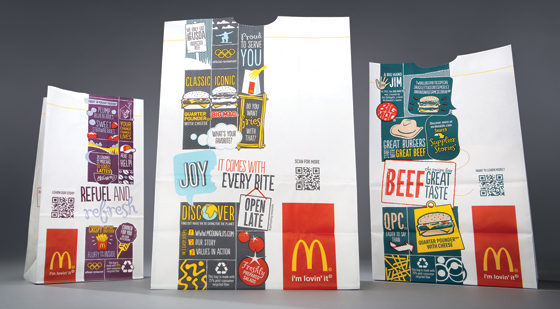Smartphones deliver robust food data; Sugar beet pulp makes ‘green’ packaging
CUTTING EDGE TECHNOLOGY

Smartphones deliver robust food data
While many home cooks have used their smartphones or tablets to find a recipe to prepare a meal or to ensure their holiday feast is both delicious and safe, this behavior is just scratching the surface of how mobile device technology may be applied to the food chain. McDonald’s is a case in point. The global fast-food purveyor has recently unveiled new packaging designs on all carryout bags and fountain beverage cups with QR (Quick Response) codes. Consumers can use their mobile devices to scan the QR codes and access nutrition information, such as calories and sodium content. The new packaging is hitting the American market first and will continue rolling out worldwide through 2013, with the text being translated into 18 different languages.
In Australia, McDonald’s launched a smartphone app called TrackMyMacca’s (Australians refer to McDonald’s as Macca’s) that enables customers to track where their ingredients in their food comes from. The free app uses the smartphone’s GPS, image recognition, plus the date and time, to access McDonald’s extensive supply chain. The information is presented in 3D animation. More than 150 million specially marked packages will be coded for the app, which will be available through June.
Canadian organic baker One Degree Organics uses traceability technology to track each ingredient back to its origin. Each bakery products’ packaging is printed with a QR code that can be scanned with a smartphone for immediate access to a detailed life story of each ingredient. Users can “meet” farmers supplying the ingredients in their products via a video and photos and information for each ingredient.
Sugar beet pulp makes ‘green’ packaging
More than 1 million tons of sugar beet pulp—leftover residue from sugar extraction—are generated annually by U.S. beet sugar processors. Some of it goes into feed for livestock and horses. Government and academic researchers have teamed up to find more profitable uses for the pulp. U.S. Dept. of Agriculture’s Agricultural Research Service (USDA ARS) Chemist LinShu Liu, Plant Physiologist Arland Hotchkiss, and colleagues with the Dairy and Functional Foods Unit at ARS’s Eastern Regional Research Center in Wyndmoor, Pa., in collaboration with Professor Jinwen Zhang of Washington State University (WSU), have developed a biodegradable thermoplastic that could be used in disposable food containers.
The bioplastic is manufactured from both sugar beet pulp and a biodegradable polymer called polylactic acid, or PLA, using a twin-screw extruder. PLA is a commercial polymer made from the sugars in corn, sugar beet, sugarcane, switchgrass, and other plants—all of which are renewable feedstocks. The scientists showed that up to 50% sugar beet pulp can be blended with PLA to produce thermoplastic composites that retain mechanical properties similar to those of polystyrene and polypropylene—compounds used to make foam-like food packages. According to the researchers, the new thermoplastic is cost competitive with commonly used petrochemicalbased plastics.
ARS-WSU researchers also have developed other sugar beet pulp materials. Using extrusion compounding, the researchers transformed sugar beet pulp into a thermoplastic-like material using water and/or glycerol. This material can be subsequently processed by extrusion or injection molding to produce pure sugar beet pulp products. The resulting thermoplastic sugar beet pulp possesses mechanical properties that are similar to those of low-density polyethylene, which is used for opaque plastic containers, bags, and film coverings. It can also be blended with PLA and other biodegradable polymers for enhanced water resistance.
Further development of sugar beet pulp plastic could one day yield yogurt cups, cottage cheese tubs, or other thin, opaque plastic containers. The new composite plastics containing sugar beet pulp are cost competitive when compared to materials that are made solely of PLA, according to Liu and Hotchkiss. “The technology is promising and provides a ‘green’ material for food packaging,” says Hotchkiss.
